Exploration of the Synergistic Smelting Behavior of Electroplating Sludge and Lead–Zinc Ore
Abstract
1. Introduction
2. Experimental Section
2.1. Materials
2.2. Methods
2.2.1. Experimental Methods
2.2.2. Detection Methods
3. Results and Discussion
3.1. Influence of Electroplating Sludge on the Phase Transition in Smelting Processes
3.1.1. Physical Phase Transition in Lead–Zinc Ores After Roasting with Electroplating Sludge
3.1.2. Physical Phase Transition Analysis of Raw Ore Roasted with Electroplating Sludge After Addition of Melting Agent
3.2. Analysis of the Effects of Electroplating Sludge on the Migration of Major Metal Elements in the Smelting Process
3.3. Analysis of the Effect of Electroplating Sludge on the Melting Point of the Smelting Process
4. Conclusions
Author Contributions
Funding
Data Availability Statement
Conflicts of Interest
References
- Cauvin, L.; Raghavan, B.; Bouvier, S.; Wang, X.; Meraghni, F. Multi-scale investigation of highly anisotropic zinc alloys using crystal plasticity and inverse analysis. Mater. Sci. Eng. A 2018, 729, 106–118. [Google Scholar] [CrossRef]
- Pola, A.; Tocci, M.; Goodwin, F. Review of Microstructures and Properties of Zinc Alloys. Metals 2020, 10, 253. [Google Scholar] [CrossRef]
- Ng, K.S.; Head, I.; Premier, G.C.; Scott, K.; Yu, E.; Lloyd, J. A multilevel sustainability analysis of zinc recovery from wastes. Resour. Conserv. Recycl. 2016, 113, 88–105. [Google Scholar] [CrossRef]
- Liu, F.; Wang, J.L.; Peng, C.; Liu, Z.; Wilson, B.P.; Lundström, M. Recovery and separation of silver and mercury from hazardous zinc refinery residues produced by zinc oxygen pressure leaching. Hydrometallurgy 2019, 185, 38–45. [Google Scholar] [CrossRef]
- Deng, X.; Huang, R.; Lv, X. Separation and recovery of metallic zinc and iron concentrate from blast furnace dust by vacuum carbothermal reduction. Transactions of The Institution of Chemical Engineers. Process Saf. Environ. Prot. Part B. 2022, 162, 746–751. [Google Scholar] [CrossRef]
- Salihoglu, G.; Pinarli, V. Steel foundry electric arc furnace dust management: Stabilization by using lime and Portland cement. J. Hazard. Mater. 2008, 153, 1110–1116. [Google Scholar] [CrossRef]
- Xu, X.; Guo, Z.Q.; Zhu, D.Q.; Pan, J.; Yang, C.; Li, S. Application of coal-based direct reduction-magnetic separation process for recycling of high-iron-content non-ferrous metallurgical wastes: Challenges and opportunities. Process Saf. Environ. Prot. Trans. Inst. Chem. Eng. Part B 2024, 183, 59–76. [Google Scholar] [CrossRef]
- Mao, L.; Wu, Y.Q.; Zhang, W.; Huang, Q.Q. The reuse of waste glass for enhancement of heavy metals immobilization during the introduction of galvanized sludge in brick manufacturing. J. Environ. Manag. 2019, 231, 780–787. [Google Scholar] [CrossRef]
- Ma, N.Y.; Sammon, W.J. Enhancement of in-plant recycling of integrated steel mill offgas solid wastes by reallocating crucial zinc-bearing materials. J. Clean. Prod. 2020, 251, 119783. [Google Scholar] [CrossRef]
- Zhou, J.Z.; Wu, Y.Y. Effective self-purification of polynary metal electroplating wastewaters through formation of layered double hydroxides. Environ. Sci. Technol. 2010, 44, 8884–8890. [Google Scholar] [CrossRef]
- Chen, H.; Yuan, H.H.; Mao, L.Q.; Hashmi, M.Z.; Xu, F.N.; Tang, X.J. Stabilization/solidification of chromium-bearing electroplating sludge with alkali-activated slag binders. Chemosphere 2020, 240, 124885.1–124885.9. [Google Scholar] [CrossRef] [PubMed]
- Guo, S.; Wang, H.M.; Liu, X.M.; Zhang, Z.Q.; Liu, Y. Approaches for the Treatment and Resource Utilization of Electroplating Sludge. Materials 2024, 17, 1707. [Google Scholar] [CrossRef]
- Mocellin, J.; Mercier, G.; Morel, J.L.; Charbonnier, P.; Blais, J.F.; Simonnot, M.O. Recovery of zinc and manganese from pyrometallurgy sludge by hydrometallurgical processing. J. Clean. Prod. 2017, 168, 311–321. [Google Scholar] [CrossRef]
- Wang, H.; Liu, X.; Zhang, Z.Q. Approaches for electroplating sludge treatment and disposal technology: Reduction, pretreatment and reuse. J. Environ. Manag. 2024, 349, 119535. [Google Scholar] [CrossRef]
- Pinto, F.M.; Pereira, R.A.; Souza, T.M.; Saczk, A.A.; Magriotis, Z.M. Treatment, reuse, leaching characteristics and genotoxicity evaluation of electroplating sludge. J. Environ. Manag. 2021, 280, 111706. [Google Scholar] [CrossRef]
- Zhou, A.; Zhang, L.; Zhou, Y.; Li, Y.B.; Wu, X.S.; Xia, L.G.; Liu, Z.H. Co-Smelting Process of Pb Concentrate and Zn Leaching Residues with Oxygen-Rich Side Blowing Furnaces: Industrial Application and Material Balance. JOM 2023, 75, 5833–5846. [Google Scholar] [CrossRef]
- Guo, Z.Q.; Pan, J.; Zhu, D.Q.; Zhang, F. Green and efficient utilization of waste ferric-oxide desulfurizer to clean waste copper slag by the smelting reduction-sulfurizing process. J. Clean. Prod. 2018, 199, 891–899. [Google Scholar] [CrossRef]
- Zuo, Z.L.; Feng, Y.; Dong, X.J.; Luo, S.; Ren, D.D.; Zhang, W.W.; Lin, H.; Lin, X.Q. Energy absorption characteristics and kinetics of carbonaceous solid waste gasification with copper slag as heat carrier. Int. J. Hydrogen Energy 2022, 47, 20076–20086. [Google Scholar] [CrossRef]
- Sun, Q.; Yang, H.F.; Gao, Y.L. Synchronous stabilization of Pb, Zn, Cd, and As in lead smelting slag by industrial solid waste. Chemosphere 2023, 339, 139755.1–139755.11. [Google Scholar] [CrossRef]
- Lei, T.; Tang, C.B.; Xiao, J.; Zeng, P.; Tang, M.T.; Wang, Z.; Zhang, Z.H. A cleaner process for lead recovery from lead-containing hazardous solid waste and zinc leaching residue via reducing-matting smelting-ScienceDirect. J. Clean. Production. 2019, 241, 118328. [Google Scholar]
- Liu, W.N.; Shi, Y.; Zhang, C.M.; Liu, L.M.; Li, H.Q.; Lu, B.; Xie, Y.B.; Zhuang, C.B.; Sun, T.Y.; Liu, W.P. Environmental impact of typical zinc that implements solid waste collaborative utilization in China. Int. J. Life Cycle Assess. 2022, 27, 1316–1333. [Google Scholar] [CrossRef]
- Huang, Q.; Min, X.; Chai, L.Y.; Li, Y.; Wang, Y.Y.; Ke, Y.; Peng, C.; Lu, H.; Lu, J.W.; Wang, X. Melting Properties and Bath Reduction of High-Zn Materials for Zinc and Lead Recovery. SSRN 2025. [Google Scholar] [CrossRef]
- Yang, J.; Chen, L.Z. Enhanced marmatite activation by copper with ammonium sulfate: An experimental and DFT investigation. Appl. Surf. Sci. 2025, 679, 161229. [Google Scholar] [CrossRef]
- Lebernegg, S.; Tsirlin, A.A.; Janson, O.; Rosner, H. The spin gap in malachite Cu2(OH)2CO3 and its evolution under pressure. Phys. Rev. B 2013, 88, 5647–5654. [Google Scholar] [CrossRef]
- Qiu, D.F.; Ke, C.M.; Wang, Q.; Zhang, S.S. Methods of recovering lead and lead compounds from spend lead paste. Inorg. Chem. Ind. 2014, 46, 16. [Google Scholar]
- Xiong, Y.; Yao, H.; Qiu, D.; Omran, M.; Wei, S.Y.; Ren, J.; Lu, C.Y.; Cao, S.; Wei, T.D.; Yu, Y.W. Influence of localized thermal effect of microwave heating on the carbothermic reduction process of ZnFe2O4. J. Clean. Prod. 2024, 477, 143887. [Google Scholar] [CrossRef]
- Tan, J.; Du Jiaheng, W.Z.; Yan, J.; He, K.; Duan, K.; Yin, Y.; Li, Z. Antibacterial magnesium oxide-calcium phosphate composite coating prepared by combining electrodeposition and sol-gel impregnation. Chin. J. Tissue Eng. Res. 2024, 28, 4663. [Google Scholar]
- Huang, Q.Y.; Li, Y.; Lu, J.W.; Huang, L.Y.; Yu, M.X.; Ke, Y.; Peng, C.; Min, X.B. Research selection of slag property of high-zinc materials bath reduction smelting for co-recovery of zinc, lead and copper. J. Cent. South Univ. (Sci. Technol.) 2023, 54, 538–547. [Google Scholar]
- Nagy, R.; Lui Wei, C.K.; Wollentin, R.W. Calcium Zinc Silicate Phosphor. J. Electrochem. Soc. 2019, 99, 137. [Google Scholar] [CrossRef]
- Sherif, H.H.A.; Hamzaey, E.M.A.; El Zawawi, I.K.; Kenawy, S.H.; El Bassyouni, G.T.; Mahdy, M.A. Novel nanocomposite made of calcium zinc silicate/NiO2 for biomedical applications. Ceram. Int. 2024, 50, 12459–12471. [Google Scholar] [CrossRef]
- Liu, Y.; Tan, J.; Liu, C.Q.; Yin, Z.L.; Chen, Q.Y.; Zhang, P.M.; Liao, Z. Thermodynamic analysis on iron-making process of zinc leaching residue by carbon reduction. Chin. J. Nonferrous Met. 2015, 25, 9. [Google Scholar]
- Wang, L.; Xu, K.; Wang, H.; Chen, S.; Yu, Z.; Ma, K.; Wu, K.T.; Xia, L. The transformation behaviour of ZnFe2O4 spinel particles in the CaO-FexO-SiO2-ZnO slag system. J. Phys. Conf. Series. 2024, 2738, 12–26. [Google Scholar] [CrossRef]
- Block, T.; Schmuecker, M. Metal oxides for thermochemical energy storage: A comparison of several metal oxide systems. Sol. Energy 2016, 126, 195–207. [Google Scholar] [CrossRef]
- Zhang, H.X.; Chen, H.; Chen, F.; Chen, Q.S.; Ying, Z.B.; Wu, X.L.; Wang, J.E. Silicon Control and Heat Balance Calculation in Roasting Process of High Silicon Zinc Sulfide Concentrate. Nonferrous Met. Eng. 2024, 14, 61–66. [Google Scholar]
- Shevchenko, M.; Jak, E. Experimental liquidus study of the binary PbO-ZnO and ternary PbO-ZnO-SiO2 systems. Ceram. Int. 2019, 45, 6795–6803. [Google Scholar] [CrossRef]
- Wang, W.A.; Qiu, G.X.; Wang, X.M. Effect of CaO on zinc migration mechanism and kinetics during zinc ferrite reduction. Trans. Nonferrous Met. Soc. China 2023, 33, 2832–2842. [Google Scholar] [CrossRef]
- Jiang, C. Thermodynamic Calculation of Phosphorus Distribution Ratio and Components activityof CaO-SiO2-FeO-MnO-MgO-P2O5Converter Slag; Chongqing Universit: Chongqing, China, 2018. [Google Scholar]
- Rincent, C.; Castillo-Sánchez, J.R.; Gheribi, A.E.; Harvey, J.P. On the exploration of the melting behavior of metallic compounds and solid solutions via multiple classical molecular dynamics approaches: Application to Al-based systems. Phys. Chem. Chem. Phys. PCCP 2023, 25, 10866–10884. [Google Scholar] [CrossRef]

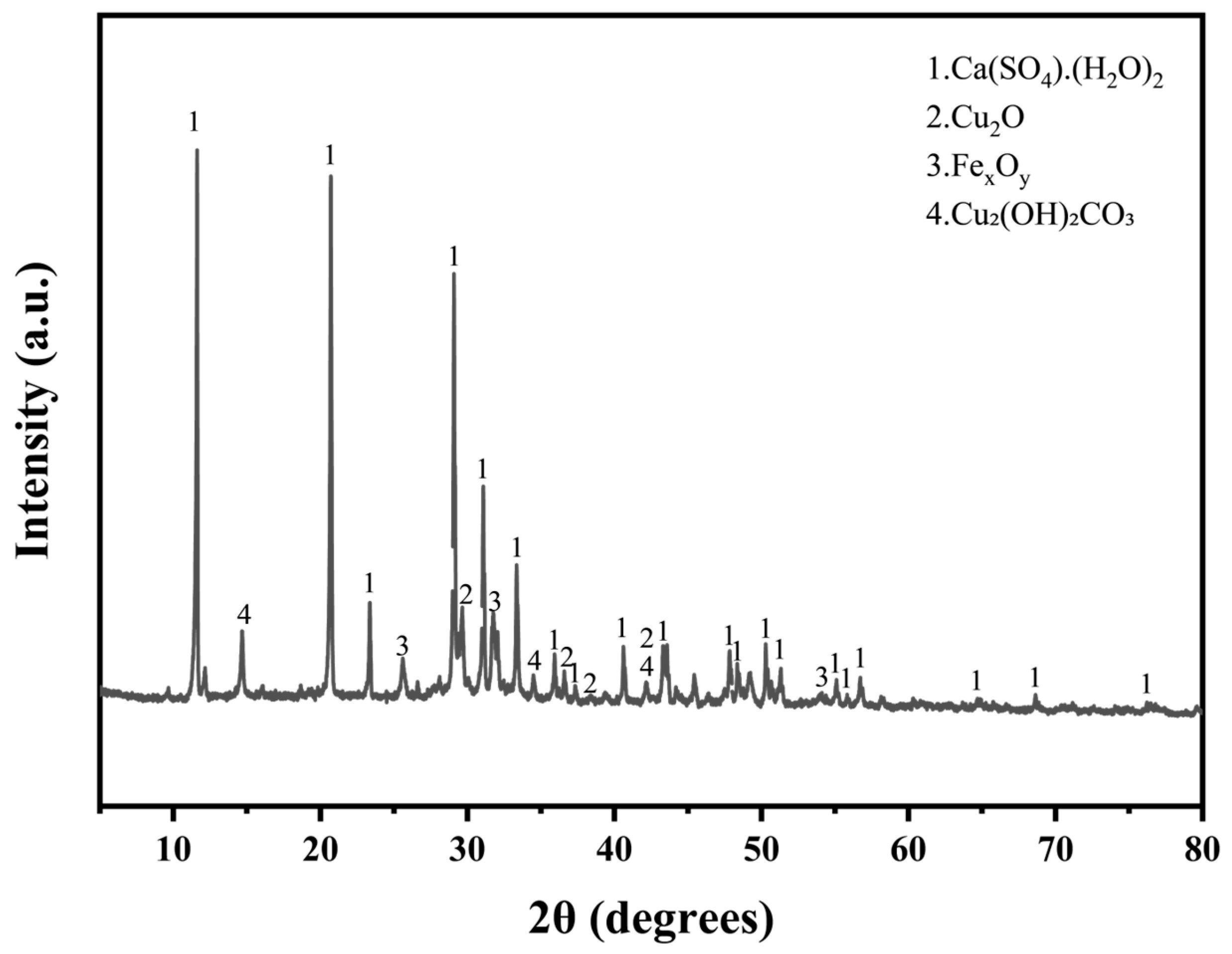
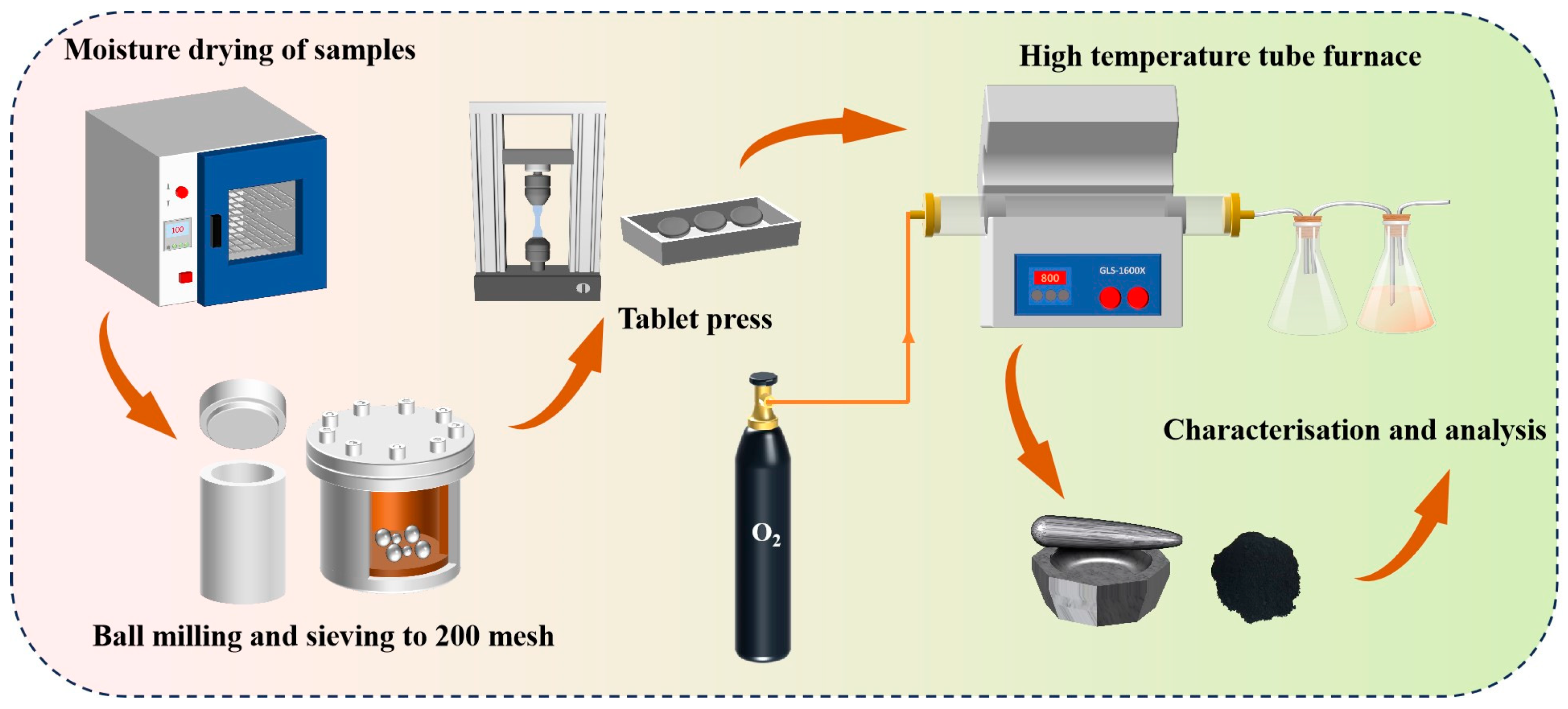
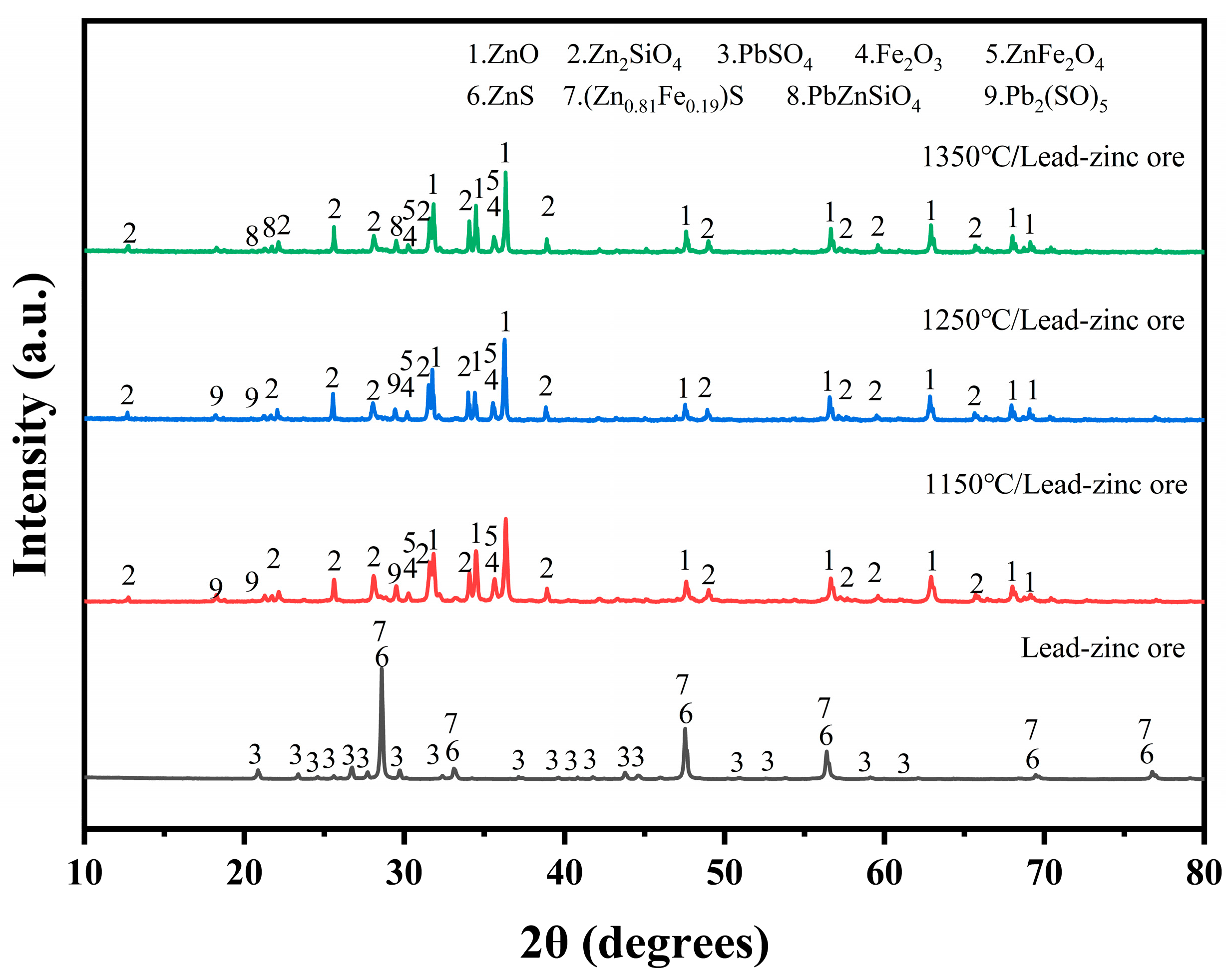
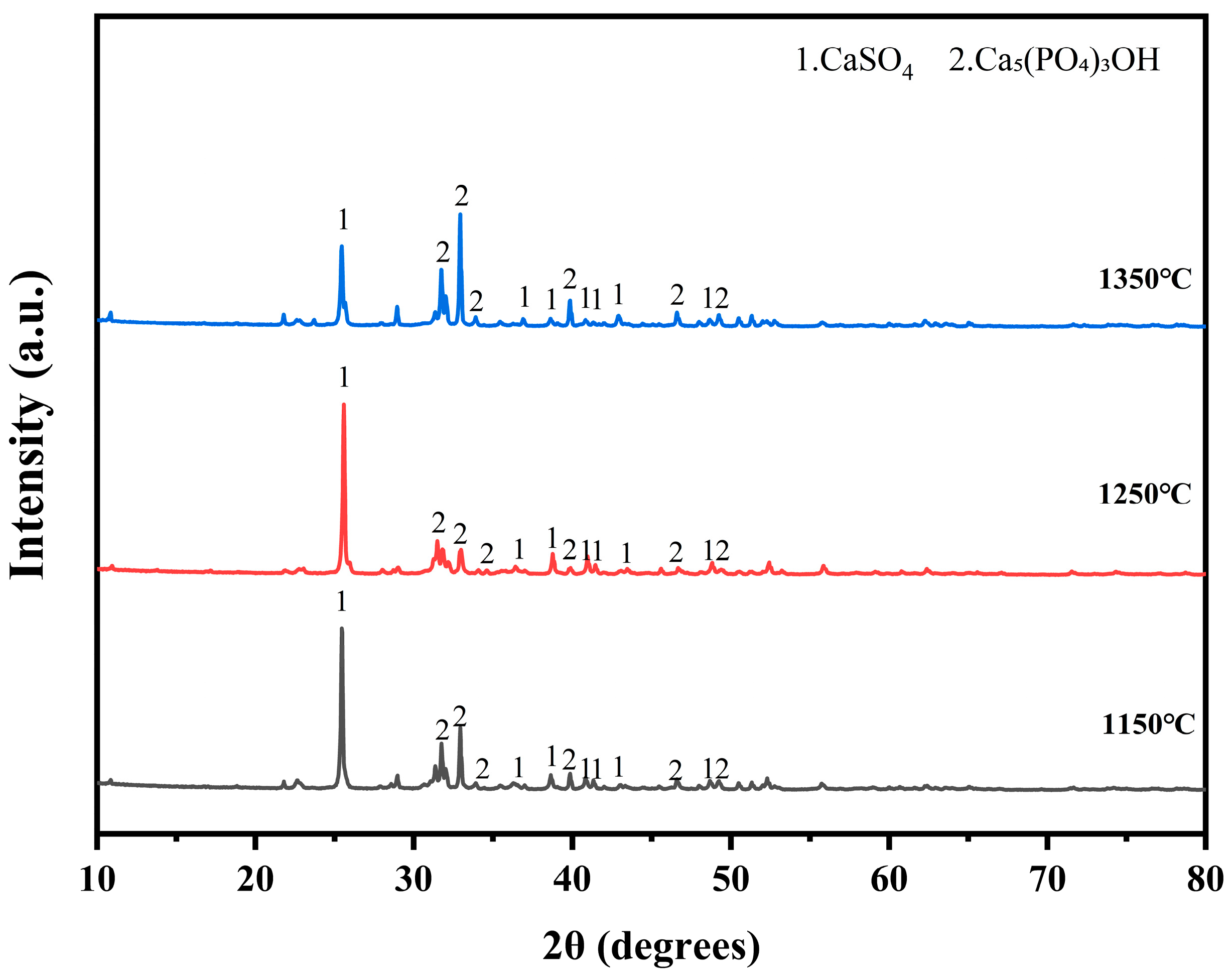

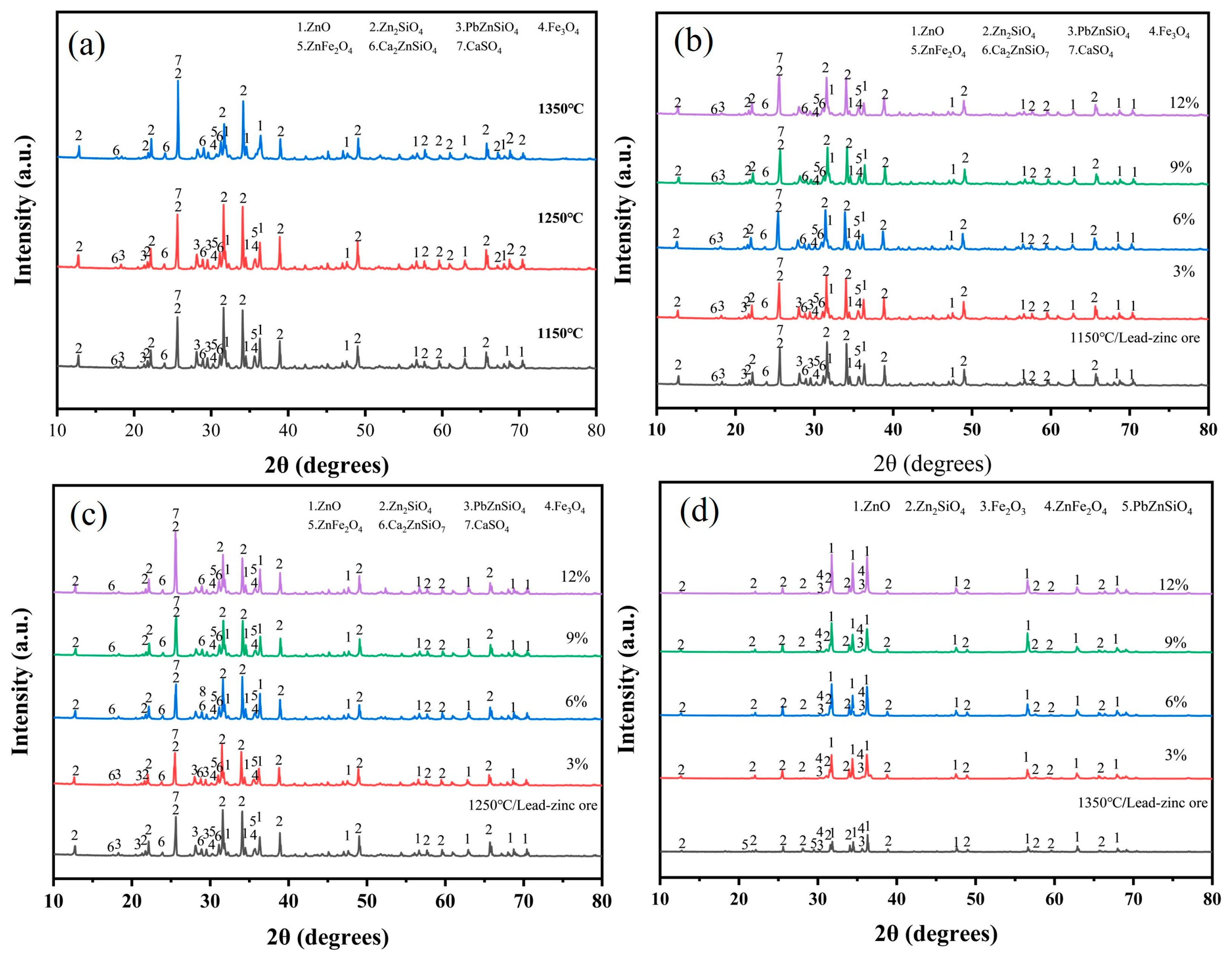
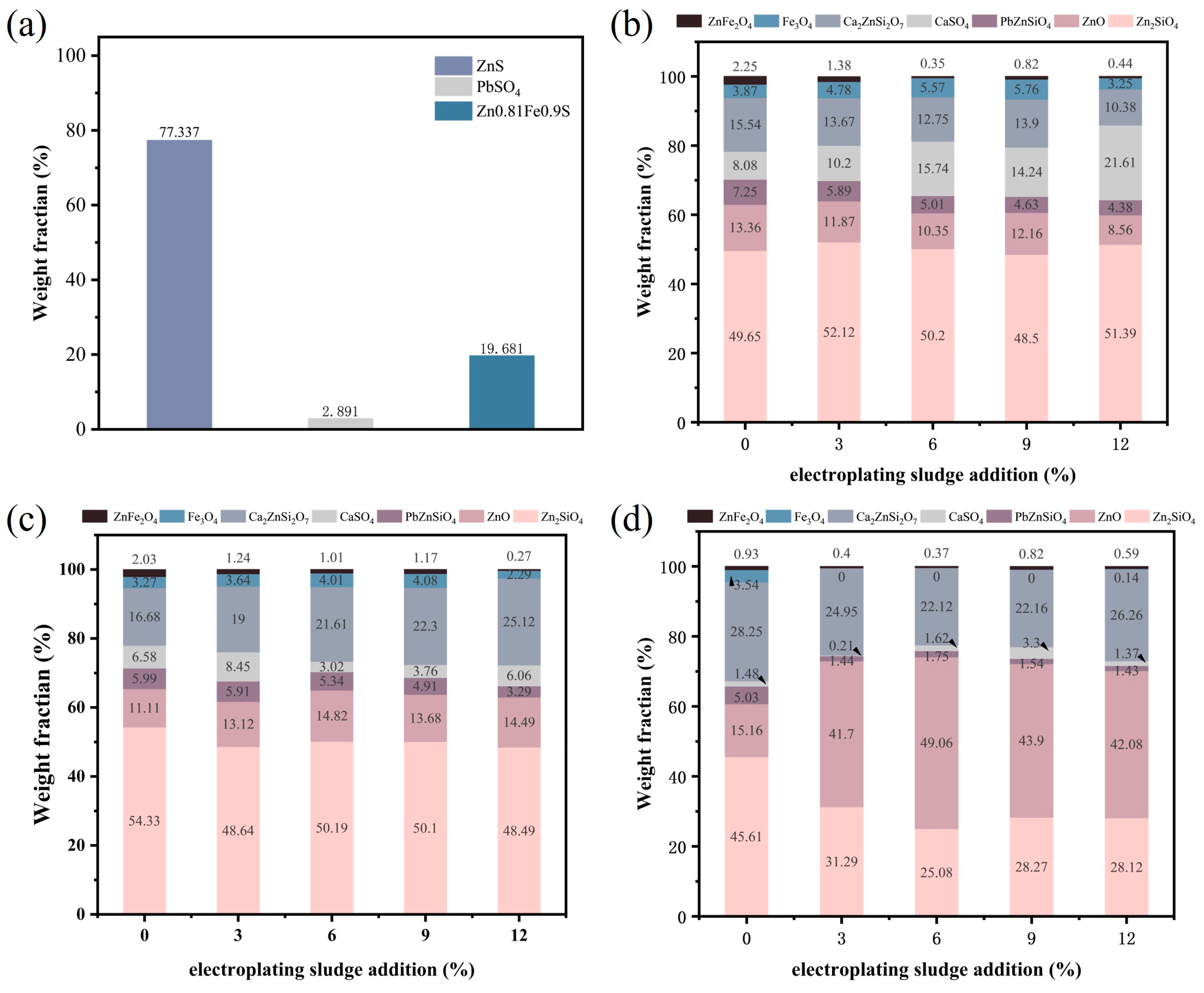

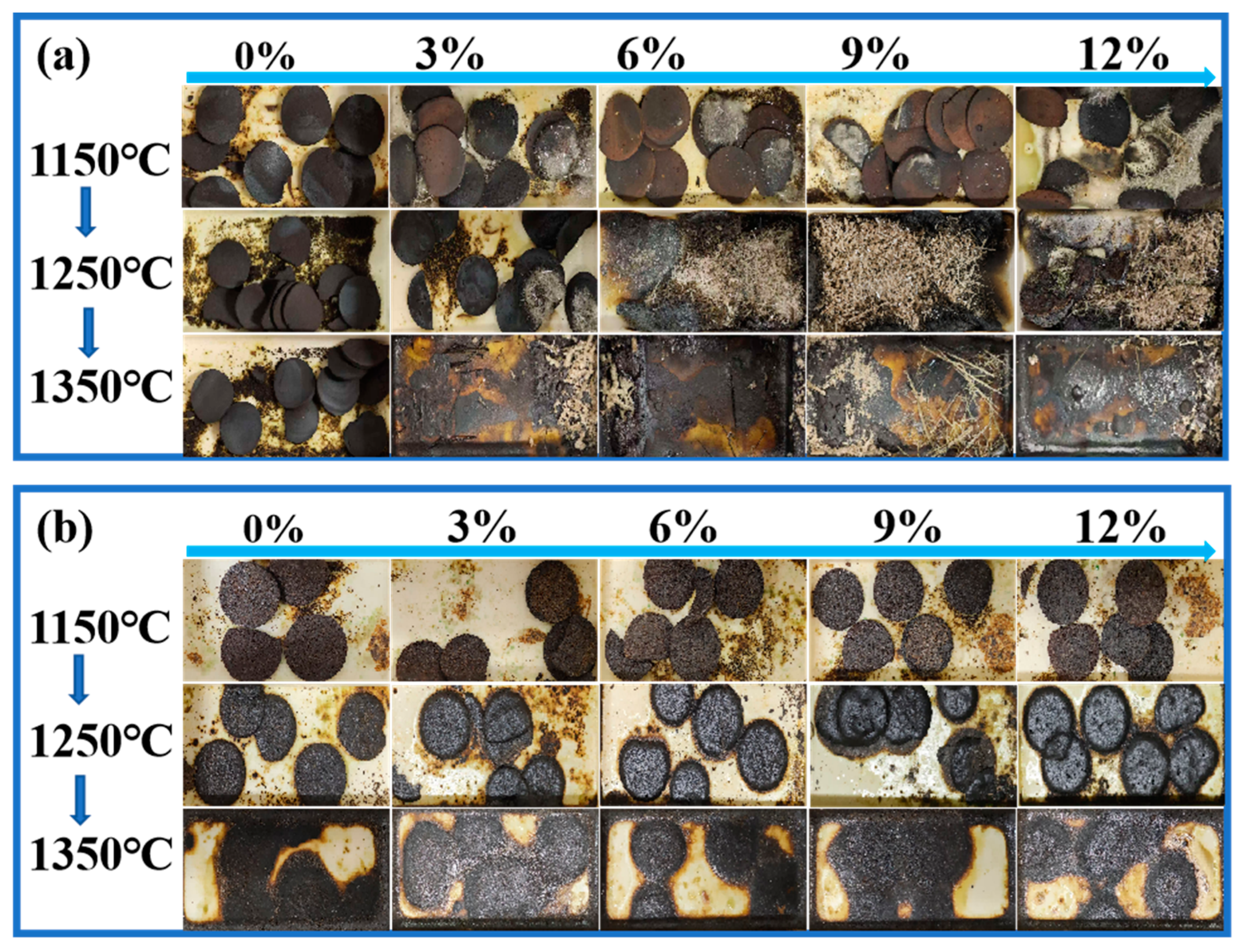


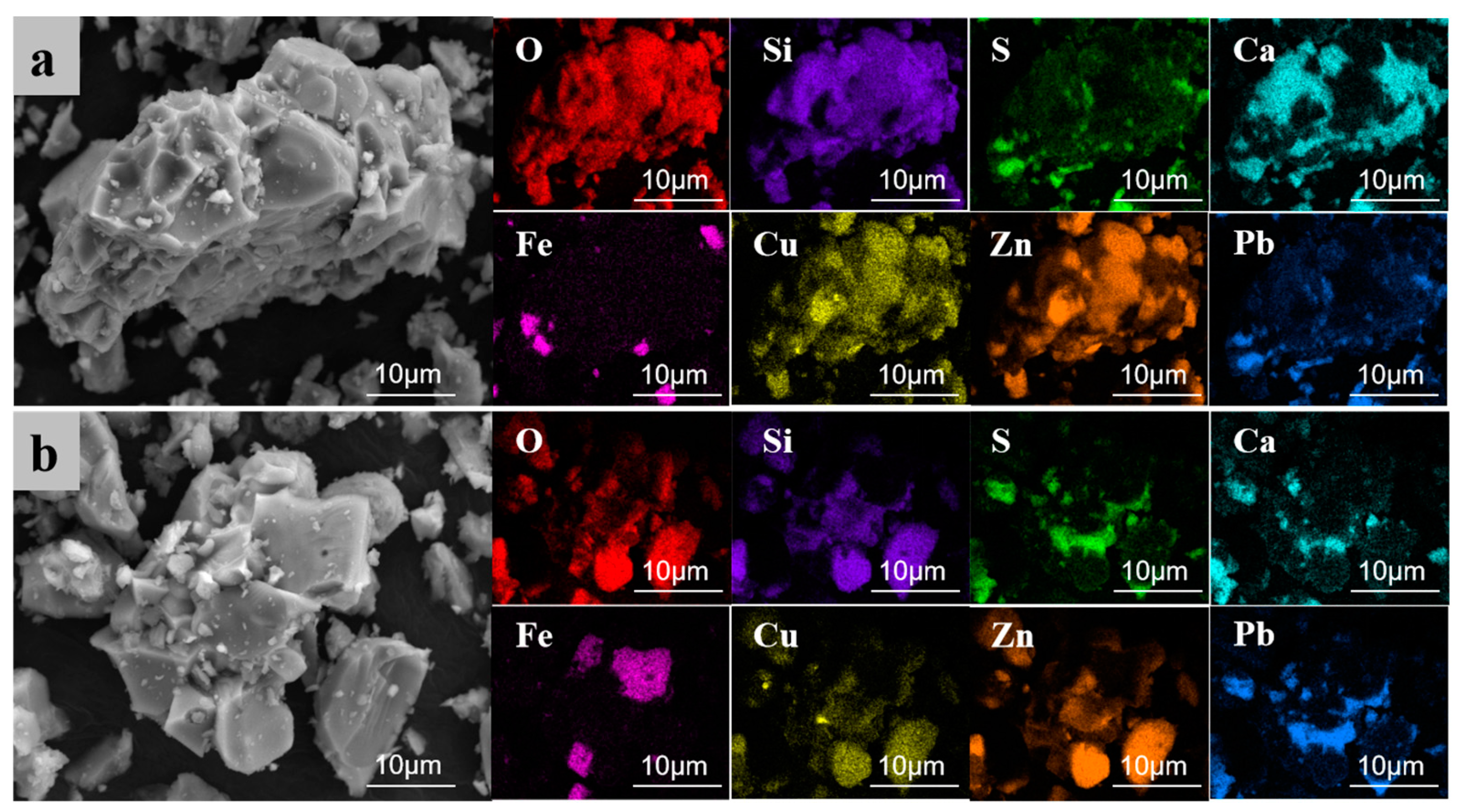
| Zn | Pb | Ca | Fe | S | Si | Cu | Cl | |
|---|---|---|---|---|---|---|---|---|
| Lead–zinc ore | 47.0 | 9.32 | 0.19 | 3.34 | 24.20 | 4.24 | 0.58 | 0.07 |
| Electroplated sludge | 0.84 | / | 24.7 | 17.9 | 15.1 | 2.27 | 29.5 | 1.02 |
| Temperature/°C | Amount of Electroplating Sludge | Zn | Pb | Ca | S | Si | Cu |
|---|---|---|---|---|---|---|---|
| 1150 | 0 | 55.26 | 10.56 | 0.16 | 0.22 | 4.65 | 0.66 |
| 3% | 51.27 | 8.87 | 0.69 | 3.62 | 3.41 | 0.78 | |
| 6% | 52.03 | 10.05 | 1.27 | 2.07 | 3.61 | 0.84 | |
| 9% | 49.46 | 9.93 | 2.09 | 2.85 | 3.60 | 0.93 | |
| 12% | 46.80 | 8.35 | 2.80 | 5.21 | 2.83 | 0.98 | |
| 1250 | 0% | 56.44 | 8.73 | 0.15 | 0.17 | 4.99 | 0.67 |
| 3% | 52.75 | 10.60 | 0.90 | 0.85 | 4.62 | 0.75 | |
| 6% | 55.41 | 4.89 | 1.52 | 0.65 | 5.46 | 0.83 | |
| 9% | 50.53 | 4.84 | 2.80 | 3.05 | 4.78 | 0.76 | |
| 12% | 50.30 | 5.78 | 3.36 | 3.16 | 4.25 | 0.70 | |
| 1350 | 0% | 56.74 | 8.68 | 0.18 | 0.05 | 4.76 | 0.03 |
| 3% | 76.78 | 4.55 | 1.27 | 0.40 | 6.37 | 0.99 | |
| 6% | 77.84 | 3.46 | 2.06 | 0.32 | 5.83 | 0.56 | |
| 9% | 74.93 | 2.80 | 2.84 | 0.23 | 6.22 | 1.47 | |
| 12% | 73.33 | 2.02 | 3.76 | 0.04 | 6.02 | 0.64 |
| Temperature/°C | Amount of Electroplating Sludge | Zn | Pb | Cu | Ca | Si | S |
|---|---|---|---|---|---|---|---|
| 1150 | 0 | 41.01 | 7.62 | 0.48 | 6.21 | 7.31 | 3.94 |
| 3% | 40.01 | 7.48 | 0.46 | 6.47 | 6.65 | 5.02 | |
| 6% | 36.42 | 7.00 | 0.60 | 7.73 | 5.53 | 7.12 | |
| 9% | 37.16 | 7.21 | 0.68 | 7.44 | 5.80 | 6.21 | |
| 12% | 33.94 | 6.65 | 0.71 | 8.69 | 4.94 | 8.21 | |
| 1250 | 0 | 41.12 | 7.64 | 0.48 | 5.94 | 7.90 | 3.46 |
| 3% | 40.66 | 7.96 | 0.57 | 6.21 | 7.93 | 3.09 | |
| 6% | 40.04 | 7.80 | 0.64 | 6.56 | 7.70 | 3.30 | |
| 9% | 38.28 | 7.53 | 0.73 | 7.21 | 7.39 | 4.18 | |
| 12% | 37.88 | 7.51 | 0.80 | 7.43 | 7.01 | 4.47 | |
| 1350 | 0 | 41.30 | 8.90 | 0.68 | 5.81 | 9.53 | 0.05 |
| 3% | 46.69 | 6.19 | 0.58 | 4.61 | 8.49 | 0.02 | |
| 6% | 47.32 | 5.36 | 0.64 | 4.52 | 7.63 | 0.02 | |
| 9% | 45.60 | 6.22 | 0.77 | 5.14 | 8.39 | 0.02 | |
| 12% | 45.21 | 6.11 | 0.90 | 6.09 | 8.66 | 0.03 |
| Zn | Pb | Cu | Ca | Si | S | |
|---|---|---|---|---|---|---|
| Lead–zinc ore | 41.12 | 7.64 | 0.48 | 5.94 | 7.90 | 3.46 |
| 3% increments | 40.66 | 7.96 | 0.57 | 6.21 | 7.93 | 3.09 |
| 6% increments | 40.04 | 7.80 | 0.64 | 6.56 | 7.70 | 3.30 |
| 9% increments | 38.28 | 7.53 | 0.73 | 7.21 | 7.39 | 4.18 |
| 12% increments | 37.88 | 7.51 | 0.80 | 7.43 | 7.01 | 4.47 |
Disclaimer/Publisher’s Note: The statements, opinions and data contained in all publications are solely those of the individual author(s) and contributor(s) and not of MDPI and/or the editor(s). MDPI and/or the editor(s) disclaim responsibility for any injury to people or property resulting from any ideas, methods, instructions or products referred to in the content. |
© 2025 by the authors. Licensee MDPI, Basel, Switzerland. This article is an open access article distributed under the terms and conditions of the Creative Commons Attribution (CC BY) license (https://creativecommons.org/licenses/by/4.0/).
Share and Cite
Wu, M.; Wang, C.; Peng, C.; Li, K.; Shi, L. Exploration of the Synergistic Smelting Behavior of Electroplating Sludge and Lead–Zinc Ore. Separations 2025, 12, 69. https://doi.org/10.3390/separations12030069
Wu M, Wang C, Peng C, Li K, Shi L. Exploration of the Synergistic Smelting Behavior of Electroplating Sludge and Lead–Zinc Ore. Separations. 2025; 12(3):69. https://doi.org/10.3390/separations12030069
Chicago/Turabian StyleWu, Meiling, Chi Wang, Cong Peng, Kai Li, and Lei Shi. 2025. "Exploration of the Synergistic Smelting Behavior of Electroplating Sludge and Lead–Zinc Ore" Separations 12, no. 3: 69. https://doi.org/10.3390/separations12030069
APA StyleWu, M., Wang, C., Peng, C., Li, K., & Shi, L. (2025). Exploration of the Synergistic Smelting Behavior of Electroplating Sludge and Lead–Zinc Ore. Separations, 12(3), 69. https://doi.org/10.3390/separations12030069






